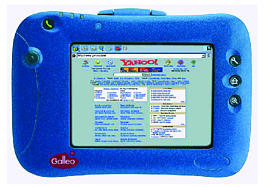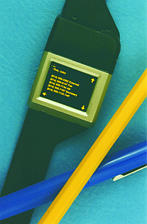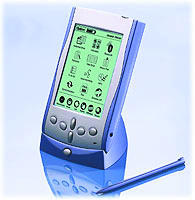
Embedded Linux was an active player at this year's European technology mega-expo held in Hannover, Germany. Lots of new devices with “Linux inside” were demonstrated or announced at CeBIT.
Sharp finally unveiled their plans for a Linux-based PDA at a CeBIT news conference. It's called the MultiMedia Tool and has a 320 x 240 color LCD and can be used to surf the Web, check e-mail, play MP3 and MPEG4 files, and also comes with a suite of PDA PIM applications. Other features are a pullout keyboard, 32MB of memory, and interfaces to USB and infrared. It also has a Secure Digital slot, the same technology used by Palm. Special software called PacketPlayer supposedly provides efficient streaming of live video from wireless sources. Rumor has it that Sharp received development support from AXE on the GUI and from Red Hat on the embedded Linux OS.
Galleo announced a Linux-based PDA/cell-phone combo device called the Mobile Multimedia Communicator. Like several other recently introduced handheld computers with wireless connectivity, this gizmo combines the functions of a PDA, web appliance and cellular phone. It sports a 320 x 240 TFT LCD, which is used in portrait mode and includes special page software that condenses standard web pages to make them easy to view on the quarter-VGA-sized screen.

Galleo's Linux-based mobile gadget combines PDA, web appliance and cellular functions.
IBM showed off a second-generation Linux wristwatch at CeBIT. This one is smaller than the original and features a bright yellow OLED (organic light-emitting diode) 640 x 480 pixel display. The watch face is now 0.65" x 0.87" in size, and the battery life has been increased to between four and six hours, as a result of some tweaking of the kernel by IBM. Let's see...that means the watch only needs to have six hour marks, instead of the usual twelve, right?

IBM's latest Linux wristwatch boasts a bright 640 x 480 pixel display.
Korean electronics powerhouse LG Electronics has announced a new Linux-based wireless webpad aimed at home users and offering internet connectivity and a built-in multimedia player. LG's Digital iPad is powered by a 206MHz Intel SA-1110 system-on-chip processor with 64MB of SDRAM memory, and it connects to the Internet via an 802.11 wireless transceiver. I/O and memory can be expanded using PCMCIA cards.

Korea's LG Electronics will soon enter the webpad market with this Linux-based device.
Similarly, Taiwan manufacturing giant MiTAC also unveiled a Linux-based, Bluetooth-connected handheld computer called the CAT. It has a 4.1" 320 x 240 pixel backlit monochrome LCD and is amply endowed with interconnection ports, including Bluetooth, IrDA, RS-232 and USB. In addition to all the usual PIM applications and internet support, software is included for playing MP3s and voice record/playback.

Taiwan's MiTAC is preparing to roll out this Bluetooth-connected handheld Linux computer.
You can now buy iPAQ PDAs preloaded with Linux in Germany. Trolltech and Lisa Systems collaborated on an Linux iPAQ solution demonstrated at CeBIT that includes the iPAQ, embedded Linux, Trolltech's Qt/Embedded and Qt Palmtop Environment (and PIM suite), custom software components from Lisa Systems for power management, internet access, MPEG player, and a KDE-based browser and file manager. The package also includes support for wireless web access using either a Nokia cardphone or a GPRS cell phone.
Esfia demonstrated a Linux-based Chinese PDA solution for the iPAQ at CeBIT that includes Esfia's RedBlue embedded Linux operating system and RedBlue/Palmlike windows launcher, an FLTK GUI application framework, the ViewML browser, PIM applications, power management, internet access, MP3/MPEG player, picture viewer, fax, e-mail, Chinese handwriting recognition, synchronization from IrDA and USB, games and a file manager.
Here are three interesting results from LinuxDevices.com's 2000 survey of embedded Linux developers.
Please vote in the new 2001 Embedded Linux Market Survey, even if you participated in last year's survey: www.linuxdevices.com/polls.